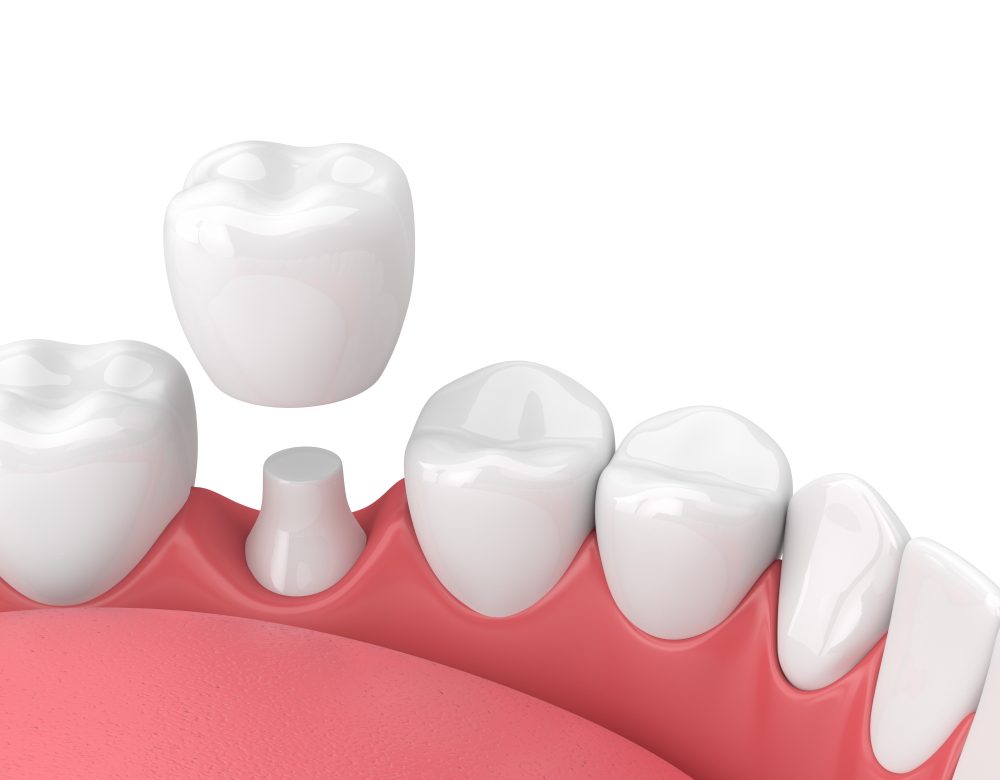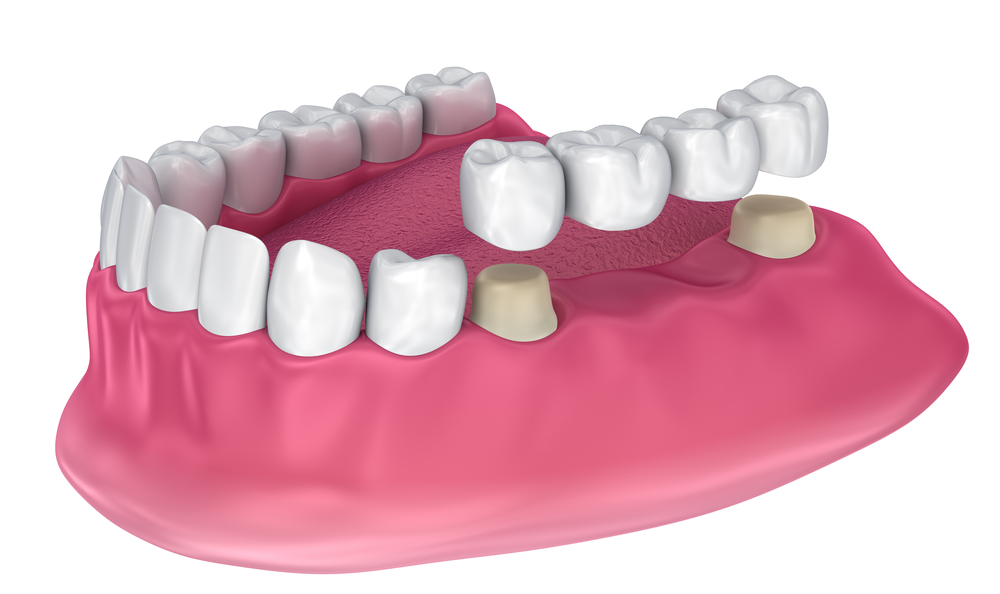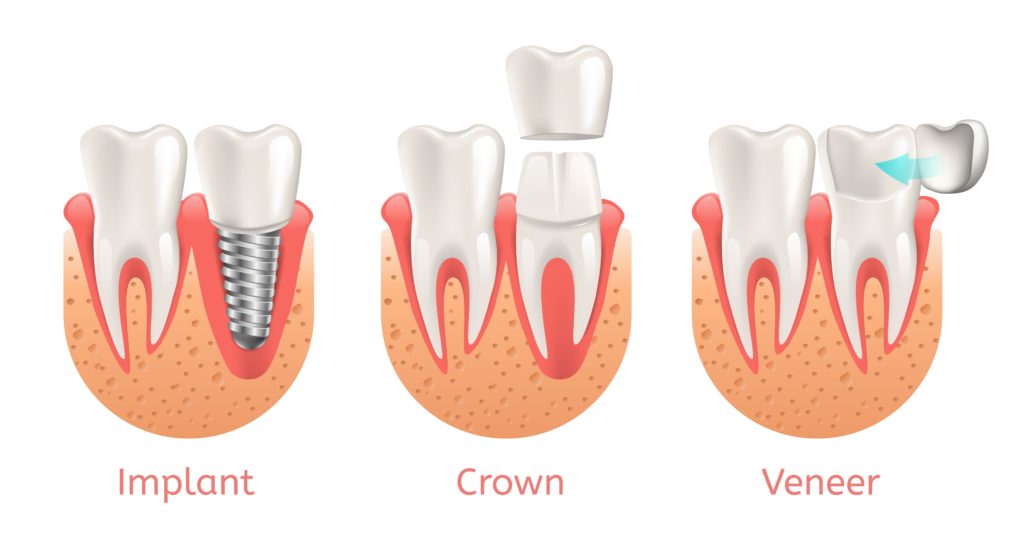Restorative Dentistry in Gilbert, AZ
Restorative dentistry serves to restore teeth that may have been damaged through common oral health problems or more serious dental issues. Tooth decay, wear, and damage are a natural result of the intense workout and bacterial influx our mouths get every day. As a cosmetic dentist, Dr. Wieckhorst can restore your damaged teeth with natural-looking materials, like composite resin fillings and porcelain crowns, inlays, and onlays. This means that you can retain an all-white smile. The benefit of restorative dentistry is that many of the procedures overlap with cosmetic dentistry procedures allowing for modern restorations that are designed to improve the look and feel of your smile and enhance your overall appearance. Often, restorative dental procedures are a result of a patient who either has overlooked the necessity of routine dental care or has a dental problem that is not visible to the naked eye. This is why we recommend visiting our dental office every six months to check for signs of tooth decay, gum disease, or other dental health issues that may be prevented before they become costly or more serious. Below is a list of the common restorative dentistry procedures that we provide to help you with issues that may affect your teeth, gums, or smile.

A Dental crown (or cap) is a tooth-shaped “cap” that is placed over a tooth — to cover the tooth to restore its shape and size, strength, and improve its appearance.. A crown protects and strengthens tooth structure that cannot be restored with fillings or other types of restorations.
Although there are several types of crowns, porcelain (tooth colored crown) are the most popular, because they resemble your natural teeth. They are highly durable and will last many years, but like most dental restorations, they may eventually need to be replaced. Porcelain crowns are made to match the shape, size, and color or your teeth giving you a natural, long-lasting beautiful smile.
Why are Dental Crowns Needed?
A dental crown may be needed under the following circumstances:
- Protect a weak tooth from breaking
- Hold together parts of a cracked tooth
- Restore an already broken tooth or a tooth that has been severely worn down
- Cover and support a tooth with a large filling when a lot of tooth support isn’t left
- Hold a dental bridge in place
- Cover a dental implant
- Make a cosmetic modification
What are Dental Crowns Made From?
Crowns are made from several types of materials including metal alloys, ceramics, and porcelain. When a crown is made, the material often is colored to blend in with your natural teeth.
What`s Involved In Placing a Crown?
A crown procedure usually requires two appointments.
First appointment. Your first appointment will include taking several highly accurate molds (or impressions) that will be used to create your custom crown. A mold will also be used to create a temporary crown which will stay on your tooth for approximately two weeks until your new crown is fabricated by a dental laboratory.
While the tooth is numb, the dentist will prepare the tooth by removing any decay and shaping the surface to properly fit the crown. You may get a temporary crown while you wait for the permanent crown to be ready. While you have a temporary crown, the tooth may be sensitive to hot and cold. Avoid chewing gum and eating sticky foods during this time.
Second appointment. At your second appointment, your temporary crown will be removed, the tooth will be cleaned, and your new crown will be carefully placed. You will be given care instructions and will discuss regular dental visits to monitor your new crown.

Missing teeth can cause various problems, from difficulty eating and speaking, to poor nutrition and even self-confidence. There are several options available for replacing lost teeth and improving your smile. One of the options is dental bridges.
Dental bridges are a prosthesis (replacement part) that relies on support from the neighboring healthy teeth surrounding the gap left by a missing tooth or teeth. The healthy adjacent teeth, called abutments, provide support on either side.
Reasons for getting a bridge:
- Fill space of missing teeth
- Maintain facial shape
- Prevent remaining teeth from drifting out of position
- Restore chewing and speaking ability
- Restore your smile
- Upgrade from a removable partial denture to a permanent dental appliance
Reasons for getting a bridge:
- Fill space of missing teeth
- Maintain facial shape
- Prevent remaining teeth from drifting out of position
- Restore chewing and speaking ability
- Restore your smile
- Upgrade from a removable partial denture to a permanent dental appliance

Dental implants are artificial tooth roots that provide a permanent base for fixed, replacement teeth. Compared to dentures, bridges and crowns, implants are a popular and effective long-term solution for people who suffer from:
- Missing teeth
- Failing teeth
- Chronic dental problems
Implants fit and function like normal teeth, and are quickly becoming the new standard in tooth replacement. Dental implants involve a small titanium screw that is surgically placed into the jaw bone, acting as a replacement root for teeth. Implants can replace single or multiple missing teeth and will eventually fuse to the bone tissue in your gums creating additional support. The use of implants creates a natural looking smile and enhance your appearance.
Patients with missing teeth can replace them with a permanent alternative to traditional dentures that looks and feels like natural teeth. Offered by our Gilbert dental office, dental implants are custom fit to your mouth, and help with proper chewing and speaking. As they become permanent fixtures of your mouth, they require no additional maintenance outside of your normal dental routine.

In the past, if you had a tooth with a diseased nerve, you’d probably lose that tooth. Now, with “root canal therapy,” your tooth can be saved. When a tooth is cracked or has a deep cavity, bacteria can enter the pulp tissue and germs can cause an infection inside the tooth. If left untreated, an abscess may form. If the infected tissue is not removed, pain and swelling can result. This can injure your jawbones and be harmful to your overall health.
Root canal therapy involves one to three visits. During treatment, your general dentist or endodontist removes the affected tissue. Next, the interior of the tooth will be cleaned and sealed. Finally, the tooth is filled with a dental composite. If your tooth has extensive decay, your dentist may suggest placing a crown to strengthen and protect the tooth from breaking. As long as you continue to care for your teeth and gums with regular brushing, flossing, and checkups, your restored tooth can last a lifetime.
What is a Root Canal Procedure?
Tooth decay can progress down into the pulp. When this happens, the pulp can become infected. Infection of the pulp can be very painful and can also deteriorate into an abscessed tooth when infection and swelling develops in the tissues around or beneath the tooth. When the pulp becomes infected or the tooth becomes abscessed, it is necessary to perform a root canal.
Why do I feel pain?
When the pulp becomes infected due to a deep cavity or fracture, bacteria can seep in. When there has been an injury due to trauma, the pulp can die. Damaged or dead pulp causes increased blood flow, pressure, and cellular activity. Pain in the tooth is commonly felt when biting down or chewing, and eating or drinking hot and/or cold foods and beverages.
Why do I need root canal therapy?
The tooth will not heal by itself. Without treatment, the infection will spread. The bone around the tooth will begin to degenerate, and the tooth may fall out. Pain usually worsens until one is forced to seek emergency dental attention. The only alternative is extraction of the tooth, which can cause the surrounding teeth to shift, resulting in a bad bite. Though an extraction is cheaper, the space left behind will require an implant or a bridge, which can be more expensive than root canal therapy. If you have the choice, it’s always best to keep your original teeth.
What are the risk and complications with root canal therapy?
More than 95 percent of root canal therapies are successful. However, sometimes a case needs to be redone due to diseased canal offshoots that went undetected, or the fracturing of the canal filling. More commonly, a root canal therapy will fail altogether, marked by the return of pain.
What happens after root canal therapy?
Once root canal therapy is completed, the endodontist will refer the patient back to our office for the permanent restoration on the tooth. A temporary filling was placed immediately following the root canal therapy and will need to be replaced with a permanent filling or crown and build up. A crown will be necessary on all posterior teeth to properly protect the root canal- treated tooth from fracturing. Front teeth can typically be restored with a filling, however a crown may be necessary in some cases. Your dentist will determine the best choice for your individual needs.
How long will the restored tooth last?
Your restored tooth could last a lifetime, if you continue to care for your teeth and gums. However, regular checkups are necessary. As long as the root(s) of a treated tooth are nourished by the tissues around it, your tooth will remain healthy.
How does root canal therapy save my tooth?
- An opening is made through the crown of the tooth into the pulp chamber.
- The pulp is removed, and the root canals are cleaned, enlarged and shaped.
- Medications may be put in the pulp chamber and root canal(s) to help get rid of germs and prevent infection.
- A temporary filling will be placed in the crown opening to protect the tooth between dental visits. Your dentist may leave the tooth open for a few days to drain. You might also be given medicine to help control infection that may have spread beyond the tooth.
- The temporary filling is removed and the pulp chamber and root canal(s) are cleaned and filled.
- In the final step, a gold or porcelain crown is usually placed over the tooth.
An infected tooth is a serious condition and must be treated promptly to avoid tooth loss and the spreading of infection to other teeth. If you are concerned about an infected or abscessed tooth, we urge you to call Cobblestone Dental Care promptly.

Tooth restoration is a branch of dentistry that repairs a damaged tooth and its surrounding tooth structure. Cracked or broken teeth can become decayed, and left untreated, can lead to infections, abscesses, and tooth loss.
Should your teeth ever require a restorative treatment, rest assured knowing we will always discuss with you the available options, and recommend what we believe to be the most comfortable and least invasive treatment. Providing you with excellent care is our number one priority when creating your beautiful smile.
Reasons for restorative dentistry:
- Enhance your smile
- Fill in unattractive spaces between teeth
- Improve or correct an improper bite
- Prevent the loss of a tooth
- Relieve dental pain
- Repair damaged and decayed teeth
- Replace missing teeth
- Replace old, unattractive dental treatments
- Restore normal eating and chewing
- Corrects crooked or displeasing shapes of teeth
- Protects damaged teeth from decay
- Prevents further tooth, gum, or tissue decay
- Improves tooth enamel to lessen tooth sensitivity
- Supports a dental bridge
- Minimizes gum irritation
Examples of restorations include the following:
- Fillings are the most common type of dental restoration. Teeth can be filled with gold, silver amalgam, or tooth-colored plastic materials called composite resin fillings.
- Crowns are a tooth-shaped “cap” that is placed over a tooth to restore its shape and size, strength, appearance, to hold a bridge in place or cover a dental implant.
- Bridges are false teeth that are designed to “bridge” the gap created by one or more missing teeth. Bridges can be anchored on either side by crowns and cemented permanently into place.
- Implants are replacement tooth roots. Implants are actually a small post made of metal that are placed into the bone socket where teeth are missing. The implant is covered with a replacement tooth called a crown.
- Dentures are a removable replacement for missing teeth and surrounding tissues. They are made of acrylic resin sometimes combined with metal attachments. Complete dentures replace all the teeth; partial dentures are considered when some natural teeth remain and are retained by metal clasps attached to the natural teeth
Call our office today to set up an appointment and discuss tooth restoration options to improve your smile.